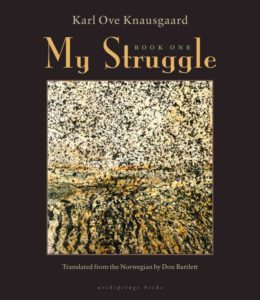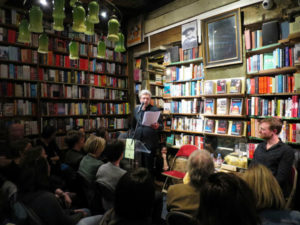
My Struggle is described by its American publisher as “the provocative and brilliant six-volume autobiographical novel by Karl Ove Knausgaard.” Over 3500 pages long, the book is divided into six volumes, originally published in Norwegian between 2009 and 2011. The first five volumes (each called “book” by the publisher) are available in English; the sixth is due in spring 2018. It’s called “autobiographical” because it describes, draws from, and reflects nothing but Knausgaard’s personal experiences, thoughts, emotions, and opinions, from the minute to the magnificent.
Karl Ove Knausgaard’s My Struggle surfaced the memory (among many other things) of a childhood project that captured my imagination for several years.
My project was to read minds. Curiosity, not personal power, drove this yearning; only strangers were eligible. What went on inside the man sitting in front of us at Mass, the substitute teacher, the lady browsing in the library? Various modes of concentration and focus didn’t break through skin and skulls, though, and eventually, I came up with a compromise. I would film someone night and day, waking and sleeping, for their whole life. Constant observation would surely yield the inner man or woman. Caught up pondering logistics such as choosing a subject and arranging for cameras, it took me a while to come to the central problem. When I did, even at the tender age of twelve I could laugh at the absurdity of it.
Knausgaard’s My Struggle nearly fulfills the near-forgotten mind-reading / life-observation project. Its many, many pages of vivid prose put you right inside not just the mind but the body, too, of someone looking out at the world and in at himself. The someone, the fictional/nonfictional protagonist, the stranger, is Karl Ove Knausgaard himself.
My Struggle includes real family, real friends close and distant, real artists living and dead, passers by, dark forests, shining lakes, bustling cities, drunken binges, stinky stairways, sex ecstatic, abysmal, and just plain fun, the simple pleasure of smoking a cig and drinking a cup of coffee first thing in the morning. It avoided the problem of my project, it left me time for my own life, not by omitting detail or clarity, but by selecting episodes.
While its aim is for truth, the book isn’t a documentary, an autobiography, or a memoir (though it’s been called all of these). It’s fair to say that if Proust’s In Search of Lost Times and Joyce’s Portrait of an Artist as a Young Man (Knausgaard loves these works) are auto-fiction, located in Lily Tuck’s illuminating essay as “part autobiography and part fiction,” so is My Struggle.

For me, the work’s ambitions bear a remarkable parallel to Walt Whitman’s. Toward the end of his life, after citing many lofty aspirations political, poetic, and social for the volume of poetry and essay he spent a life-time constructing, Whitman finally says: “Leaves of Grass indeed (I cannot too often reiterate) has mainly been the outcropping of my own emotional and other personal nature — an attempt, from first to last, to put a Person, a human being (myself, in the latter half of the Nineteenth Century, in America,) freely, fully and truly on record.” Knausgaard, in sumptuous prose — sumptuous though plain, and even when it lapses into cliche and buffoonishness — constructed from his own emotional and personal nature, in novelistic form, a person, a human being, himself, living in the latter half of the twentieth century, in Norway and Sweden.
The process resembles that used by Jeannette Walls for Half-Broke Horses: A True-Life Novel, a work Walls described as “in the vein of an oral history, a retelling of stories handed down by my family through the years, and undertaken with the storyteller’s traditional liberties.” Knausgaard’s scenes are handed down by his own memories and reflections, his emotions and thoughts, his deepest psychological formations.
In some respects My Struggle is a coming-of-age novel. Although the protagonist is, at times, a man in his forties, the “struggle” in the book, his impetus to begin the project, as I gather from interviews, was to move from being a son to being a father, to realize himself as an individual human being separate from the parent, to be a mature man. His native form being the novel, to accomplish this movement Knausgaard wrote a novel. But for this novel, he put away some fundamental contrivances of the novel: there is no plot in which made-up characters work something out in a world created just for them.
This is weird to me as a fiction reader and, as a fiction writer, daunting. I love making stuff up, and I gravitate to redemption stories and love stories, which demand a particular plot to carry a central conviction or quest that is fulfilled or failed by the protagonist in some way or other at the conclusion of the work. So amidst My Struggle, I had thoughts that this writer Karl Ove Knausgaard has kicked the novel to shit. I thought, he’s destroyed it now. Finally, someone’s done what literary writers have been trying to do for decades. I think I’m over this crisis in faith, or at least I’m willing to keep reading fiction, and of course I keep writing fiction, no choice.
It’s all been done before. It’s being done more. In an article whose title includes the words “death” and “novel,” Jonathan Sturgeon groups My Struggle with Ben Lerner’s 10:04 and Nell Zink’s The Wallcreeper. And there’s Rachel Cusk. And more. What’s different (more destructive to fiction?) about Knausgaard’s work is its rawness, its lack of contrivance, the lack of construction. These “devices” (to quote the Ben Lerner quote in Sturgeon’s essay) both efface the writer and create a narrator brimming with life.
It’s possible, reassuring, to see that My Struggle is supported by novelly stuff like world-building, characters, narrative drive, with (real-life) places, people, and events selected and formed into scenes. Knausgaard is as keen as any writer of category romance (of which I’ve read plenty) to convey emotions, love above all. Conflicted family love, deep friendship love, romantic love: for love, he goes all in. But he doesn’t create a love story, whether a tear-jerker or an HEA (category romance lingo for happily ever after). Even the conclusion — it’s conclusive, all right, but not as the end of a fictional build. Knausgaard started the six-volume book with the last line in mind: “I am happy I am no longer an author.” The final volume isn’t yet available in English, but Knausgaard himself has quoted this line in interviews. The question that follows is inevitable: Did you really mean that? The gist of his answer: Not literally. It’s the persona of My Struggle: that author is finished.
The book begins as sincerely and as deceptively as it ends.
For the heart, life is simple….
I gather that the Norwegian word hjerte includes the same figurative meanings as the English word heart. So, this is to say: In the seat of the most authentic emotions, in the throne of love, the place inside us where all is raw truth, life is simple.
For the heart, life is simple: it beats for as long as it can.
No, no. This is the heart that beats. This is the muscular organ that pumps blood through the living body.
Then it stops.
This is the heart, contracting inside our chests, that is mortal. It stops. It cannot hold undying love or eternal enmity. It has a strict and final end.
For the heart, life is simple: it beats for as long as it can. Then it stops.
The trickstery ambiguity of these opening lines pulls you in, pushes you out, while luring you yet further in. Because in this observation of the internal organ called the heart, and even in the clinical description of the death process that follows, somehow that other heart, the heart whose purpose and meaning cannot be explained, the heart that can be probed only by literature, undeniably makes its presence felt.
Knausgaard’s project was instigated by the need to write out the trauma of his father’s death. But I gather that what he really wanted to get at, by the rawest and most direct path, are death and love as they are placed in life.
The human heart as the physical organ, contracting at ease, racing with exertion, responding to the charge of adrenaline, throbbing with physical ecstasy, inert and decomposing in the chest of the dead father; the human heart as the enigmatic throne of love, fear, loathing, black despair, blissful transcendence. What can possibly be more engrossing?
When he writes, Knausgaard keeps his awareness of potential readers at bay. Yet the exploration that is My Struggle rejects and embraces the enchantments of fiction to close the distance between the reader’s (my) body and heart and a stranger’s (his) body and heart, evoking whatever we have inside ourselves, maybe a soul, that occasionally and fleetingly frees body and heart to be at last in union. ♦
On Karl Ove Knausgaard’s A Time for Everything The humans who tangle with angels in A Time for Everything do not fare well
SOURCES: Karl Ove Knausgaard. My Struggle. Translated from Norwegian by Don Bartlett. 6 volumes. Brooklyn, NY: Archipelago Books, 2009–2017.
Jonathan Sturgeon. “2014: The Death of the Postmodern Novel and the Rise of Autofiction.” link | The article quotes Ben Lerner’s intriguing fiction-killing-fiction take on My Struggle: “Breaking of the vessel of art, the renunciation of fiction, literary suicide – these are fictions, and they’re the devices on which the power of My Struggle depends.” Ultimately, Sturgeon claims victory for the novel: “Fiction includes the narratives we tell ourselves, and the stories we’re told, on the path between birth and death…. …The rise or return of autofiction isn’t the work of a movement, campaign, or vanguard: it’s more of a murmur in the heart of the novel, one that lets us know that literature is alive, still-forming — a living hypothesis.”
Lily Tuck. “True Confessions of an Auto-Fictionist: Lily Tuck on the Novelist’s Documentary Impulse.” Literary Hub, October 23, 2015. link | Of My Struggle, Tuck says: “Although our writing styles are very different, I can’t help but mention Karl Ove Knausgaard whose work—I’ve read the first two memoirs—I admire. I have also read a bunch of interviews that he has given and I identify and agree with a lot of the things he has said.” Her praise is unqualified, but “I can’t help but mention” and “agree with a lot”—but not all—implies that she avoids placing My Struggle square in the genre of auto-fiction.
Walt Whitman. “A Backward Glance o’er Travel’d Roads.” Leaves of Grass. Philadelphia: David McKay, 1891–92. The opening lines, too, of the Inscription in the 1867 Leaves of Grass could introduce My Struggle: “Small is the theme of the following Chant, yet the greatest — namely, ONE’S-SELF — that wondrous thing, a simple, separate person….” I can’t resist pointing out a few more parallels between Whitman and Knausgaard. One is that they published their first major works in the same year their fathers died. Another is their copious use of “catalogues,” lists of sense impressions, objects, places, and people, actions and qualities, sometimes similar, sometimes disparate. The sometimes loping, sometimes jagged cadences of these catalogues are integral to the gestalt they create in the reader.
Photo of Karl Ove Knausgaard: Anne Edelstam article
Many interviews with Karl Ove Knausgaard can be found online. I enjoyed these two most (both videos): Karl Ove Knausgaard and Stephen Grosz in Conversation link | Karl Ove Knausgaard & Jeffrey Eugenides link
A wonderful, intriguing essay that introduces his book(s). I’ll be reading the book(s) when I have more shelf space. Thank you.
Thanks, Lenore!
Pingback:Karl Ove Knausgaard: A Time for Everything